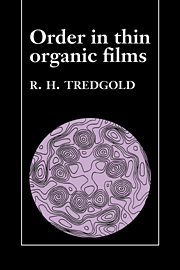Book contents
6 - Self-assembly
Published online by Cambridge University Press: 21 September 2009
Summary
Introduction
The name self-assembly is an unfortunate one as it implies the achievement of something approaching the synthesis of artificial life. However, this term has now been generally accepted and so will be used here. It has two distinct but related meanings. The majority of papers bearing this phrase in their titles concern monolayers of organic molecules adsorbed on solid inorganic surfaces. These rather simple systems can be studied and characterised at a level of detail and rigour which it is difficult to achieve with the other systems discussed in this book. They can also be formed using very simple apparatus. For both these reasons they have made a strong appeal to surface chemists. There exists, however, a more limited group of papers in which treatment of the initial organic layer by a succession of reagents has made it possible to build up ordered multilayers. In principle, this latter technique should make it possible to form the analogues of Langmuir–Blodgett Z-type multilayers and thus use relatively simple chemical methods to construct non-centrosymmetric systems of use in technology, as discussed, for example, in Chapter 5. So far such applications of this technique have not proved practicable and the difficulties involved will be discussed later in this chapter.
Monolayers formed from carboxylic acids
In recent years study of the absorption of small molecules on well characterised single crystal surfaces has attracted many research workers.
- Type
- Chapter
- Information
- Order in Thin Organic Films , pp. 116 - 134Publisher: Cambridge University PressPrint publication year: 1994
- 2
- Cited by



